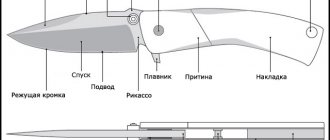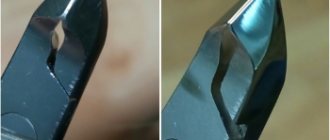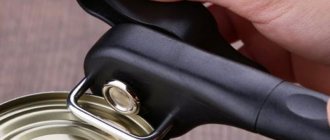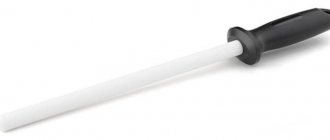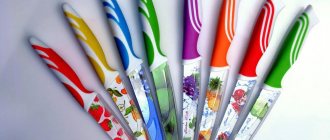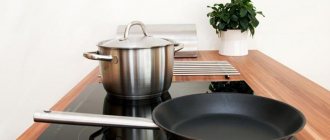To straighten the blade using the express method, cooks use musats - devices in the form of rods with an abrasive coating. Unlike other sharpening tools, knife polish does not remove large chips from the cutting edge, but only smoothes and polishes them. This is especially true for high-quality knives that have the ability to hold an edge for a long time. In this case, sharpening musat will help extend the life of the blade, maintaining its sharpness at the proper level. This rod can be used to sharpen the blade frequently without fear of premature wear.
What is knife polish
There are many different sharpening tools. These are special stones and other mechanical devices, as well as knife sharpeners powered by electricity. However, among this variety, an increasing number of people choose musats. Why are these tools so popular, and what are they?
Musat for sharpening knives is a special rod made from a sharpening base that is attached to the handle. Such instruments differ mainly in the degree of softness of the material. This indicator determines what the blade will become after using the musat: smooth or rough.
The advantage of musats is that their surface is magnetized. Thanks to this, after sharpening there will be no metal crumbs left in your kitchen; they will “stick” to the tool. To remove them, just wipe the grease with a damp cloth.
How to properly care
The device must be stored in a suspended state after use. Can be hung on a hook or placed on a stand. Washing is done with any detergent, using a washcloth or soft sponge. Following these simple rules will help increase the life of the devices.
Wash in soapy water
Can be processed with sandpaper (ceramic only)
Types of musats
Ceramic grinding stone is excellent for sharpening large and wide blades.
It is very important to choose the right tool to ensure the best effect from its use. To do this, first of all you need to pay attention to its purpose. There are such musats:
- for grinding a blade that has already been sharpened;
- for initial sharpening of knife edges.
It is also worth deciding on the material of the musat, which is most often “diamond” or ceramic.
The first type of nuts is made of hard chrome-plated steel, which is then coated with “diamond” sand. Sharpening with the help of such devices occurs very quickly. For excellent results, you just need to run the rod once along each side of the blade.
“Diamond” musats have many advantages.
In addition, a distinctive feature of “diamond” tools is their oval shape. It eliminates the possibility of indentations forming on the tip. Even if you accidentally press the nut too hard in one place, there will be no unwanted nicks or grooves left there. At the same time, the sharpening rod made of “diamond” steel is quite rough to “bring back to life” even the most dull blade. After treating the edge with “diamond” musat, it remains sharp and smooth for a long time.
With all its advantages, this kitchen appliance is also very easy to store. It does not require special care. And in order for the musat to last longer, it is enough to follow only two rules: do not put it in the same drawer with other hard objects and wash it by hand, and not in the dishwasher.
A ceramic rod is also used for sharpening and final grinding of cutting surfaces. Such models come in round or oval shape. Musat made from this material perfectly sharpens large and wide blades. It is even suitable for the “cleaver” used to cut meat. With its help, you can make a heavily worn knife sharper, and it does an excellent job of polishing the blade.
Types by function
Musat is intended for straightening a knife, but some types of tools can be used for sharpening.
For grinding
Steel grinders, which have a smooth surface, are distinguished by gentle polishing and remove a small amount of metal. For straightening, notched rods are also used, which have a velvety texture due to the large number and low height of the ribs. A rough cut is used if the edge has not only been bent, but also polished when grinding hard steels.
The coarser the rod, the more intense the material removal from the blade. To polish blades made of low-hardness steel, it is recommended to use a tool with a smooth ceramic surface. Sanding is carried out with light pressure.
For initial sharpening
Abrasive musats are suitable for sharpening.
Ceramic grinding stone for initial sharpening of knives.
These include the following types:
- With rough ceramic coating. Not for use on hard blades.
- Diamond.
The abrasive surface acts as a grindstone. The softer the material of the cutting part of the knife, the finer the spraying should be. The amount of metal to be ground depends on the grain size and the pressure applied.
Must is not used for deep sharpening, because... may damage the blade. For this purpose, it is recommended to use special machines or sharpening stones.
How to properly sharpen knives with musat
Before we talk about the rules for using this tool, it should be noted that musats are intended only for knives with a smooth blade. They cannot be used if the cutting surface is wavy or jagged.
When sharpening a knife with musat, the blade does not become thinner, but only straightens. This is its main difference from other sharpening devices. This feature allows you to use the grinder before each cooking, since even frequent sharpening will not affect the durability of the blade.
How to sharpen knives with musat? Remember that a good effect from using musat is achieved only if you use it correctly. Follow this sequence of actions:
- Place the end of the tool on a non-slip surface. A towel laid out on the kitchen table is best suited for this.
- During sharpening, hold the knife blade at an angle of 200.
- Run the cutting surface over the musat several times. First from bottom to top, and then forward and backward.
- Repeat the same steps on the other side of the blade.
It is important not to press too hard on the blade while sharpening, otherwise it may gouge.
How many times should you run a knife along the shaft of the musat to ensure that the blade becomes optimally sharp? If you are using a diamond tool, once on each side is enough. And when using a ceramic rod, you need to repeat these movements 3-6 times.
Types of devices by shape
Products may have different cross-sectional shapes. Possible options:
- Round. The tool is lightweight.
- Oval. More convenient to use, have greater contact with the surface of the knife.
- Faceted. There are flat, tetrahedral and D-shaped. In the first case, linear contact with the blade is ensured; in the second and third cases, special sharpening is carried out due to the combination of the functions of a flat and volumetric tool.
There is also a tabletop V-shaped musat. It consists of 2 rods that are installed on the base at the desired angle.
Musat with a round cross-section.
Musat with an oval cross-section.
Flat Musat.
D-shaped section of musat. Tabletop V-shaped grinder.
Dressing a knife with musat
To straighten knives you will need some grinding cloth and a non-slip surface.
Musat can be useful not only for sharpening blades, but also for straightening them. How to do it right? There are certain rules for how to sharpen a knife with musat:
- as with sharpening, place the grinder on a non-slip surface (a towel or cutting board is suitable as a “lining”);
- tilt the musat to the left 20–25 degrees;
- place the tip of the knife on the right at the very beginning of the rod and move it from the base to the tip, directing the movement downward;
- do the same with the other side of the slicing device, tilting the musat to the right.
These actions are performed until the knife blade acquires the desired sharpness.
How to choose the optimal sharpening angle
The main thing in sharpening a knife is maintaining the correct angle of inclination between the sharpening tool and the blade. The smaller the angle of inclination, the sharper the knife blade; at a larger angle, its resistance to dullness increases.
When choosing a sharpening angle for a kitchen knife, you should consider what you will be doing with it:
- If it is a cutlery, it should not leave gouged lines on the utensils. In this case, the angle ranges from 55-60°.
- Chef's tools are usually sharp at 25-30°. But if we are talking about thick, heavy cutters, then 50° is optimal for them.
- Ordinary kitchen knives are not sharpened every day, they do not cut for a long time, so an angle of 30-35° is suitable for them.
The sharpest knives are blades with a sharpening angle of 50°. Some brands of such products can cut through nails. When sharpening a knife, the angle can be varied at your discretion within this range.
Features of sharpening knives made of different materials
Steel blades require tools with abrasives that are harder than the steel of the knife itself. Ceramic, diamond chips, carbides or Arkansas stone are suitable. Only diamond-coated abrasives are suitable for ceramic knives. This is because ceramics is a fragile material that can break if handled incorrectly.
A Damascus steel knife cannot be sharpened on a diamond whetstone, as the blade may crumble. The sharpening process is very long, so it is better to leave it to a master. But knives with a wavy edge are not sharpened at all, since it will not be possible to return the saw blade to its original properties. It's easier to sharpen it to a regular one.
How can you tell if a knife is sharp enough?
After sharpening, you must check whether the blade is sharpened well. To do this, you can use one of these methods:
- Select a strand of hair at the back of your head and press the knife against it at a right angle. Swipe through hair from top to bottom without making sudden movements. If the blade is still dull, it will slip off easily, whereas a sharpened point will stick.
- Take a newspaper or sheet of paper and hold it suspended. In this position, try cutting the sheets: if you succeed, the sharpened knife is already quite sharp.
For many cooks, musat has become an indispensable item in the kitchen. This is due to the fact that it is easy to use, it does not damage knife blades and lasts a very long time if used correctly.
Blade Sharpness Determination
You can check the sharpness of the cutting edge with your finger, but do not run it along the knife. The blade should be moved across the finger. This method requires training and experience.
Checking the quality of blade editing on paper.
There are other reliable and safe methods:
- Paper. Holding the sheet suspended, you need to cut a thin strip from it. A properly sharpened knife carefully cuts through paper without creasing it. The sharper the edge, the thinner the strip you can cut.
- Tomatoes. The sharpened cutting edge easily cuts the tomato under the influence of the weight of the blade and does not crush the skin.
- Hair. This method requires caution. It is necessary to bring the blade to the hair on your arm (against your height). If the edge is not straightened, the hair will bend. A sharp edge will cut it off.
You can also check the sharpness with your fingernail. You need to apply the knife across the growth of the nail plate. With a dull edge, the blade will slide down under its own weight. The sharp blade will leave a small notch and will be held in place. The method requires careful use; sudden movements should not be made.
Types of musats by material
The material used to make the musat also plays a significant role in the purpose of the product. The most popular purpose should be recognized: grinding the blade and straightening the cutting part. But there are musats that can cope with the initial sharpening of the blade.
A blade with a score of less than 50 will eat musat instantly, and a blade with scores of more than 60 will be difficult to sharpen. But having chosen the right material for the product, sharpening or editing will take place accordingly.
Metal
Metal.
Metal musat for sharpening knives must be made from hard steel.
Which contain large amounts of chromium and vanadium. The surface is made smooth, and hardness is an advantage of such a product.
It is used for straightening the cutting edge and polishing the blade. Often, during their manufacture, steel is magnetized. When sharpening a knife, the chips do not fly in all directions, but remain on the grinder. The type of grain size of the product is selected depending on the degree of wear of the blade.
Diamond
Diamond product.
Serious and, according to professionals, the best musat for sharpening knives. Differs in speed in work.
Designed to edit and polish the blade. It is not recommended for them to sharpen knives. The product is made from chromium-rich steel.
This gives the musat excellent hardness. The surface is covered with fine grains of diamond chips. The oval shape of the product will prevent the appearance of jagged edges on the blade during awkward movement. This musat will cope with a task of any complexity.
It is recommended to store the product strictly separately from metal objects. It should be washed under running water. If you follow the rules of care and storage, the musat will last for many years.
Ceramic
Ceramics.
The ceramic product is similar in nature to the diamond version. Spraying consists of ceramic chips.
Musats are made with varying degrees of abrasiveness. Coarse-grained coating is intended for sharpening knives.
This is the key point of ceramic musat. Knives of low hardness can easily be sharpened for initial sharpening of the cutting edge. By maintaining the required angle and then bringing the blade to a fine grain, you will get an excellent sharp-nosed assistant.
Mixed option
Vintage station wagon.
Combining materials for sharpening or straightening a cutting edge gives the product versatility.
By spraying various abrasives, musat will be able to solve two problems. And a tetrahedral one means four at once.
This versatility of the product is useful for home use. Don’t be mistaken about the purpose of each surface; it’s possible to damage the cutting part of the blade in just a few movements.
